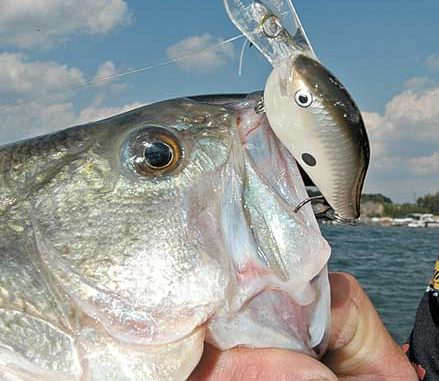
There’s a lot to like about March if you’re a bass fisherman. I think it’s a great month to fish in North Carolina. The water is starting to warm up a little bit, the fish are starting to get a little more active, and the bass are probably the biggest they’re gonna be all year, because they’re feeding up for the spawn.
Not only that, they’re not that hard to catch. A lot of different patterns will work. It’s about like June — you just throw something out there, and they’ll eat it — from jerkbait to crankbait to jig to spinnerbait.
The water temperature is going to make a difference; getting to 50 degrees is really a big deal. If the surface temperature is above 50, they’ll be active. You go out, you pay attention to what’s going on around you and try to adapt to the conditions.
The one thing that’s stable is that most of the bass you catch are going to be in 10 feet of water or less. They can be real shallow, but wherever they are, they’re going to be next to deep water. You may be sitting in the back of a creek, but you’ll be sitting in 10 feet of water, casting to the bank. You’ll find yourself on a sharp drop — not on a flat. If you spend much time fishing up on a flat in March, you’ll be wasting a lot of time. They want to go up there, but they’re not able to until the water temperature gets up in the high 50s.
Probably, one of my favorite patterns is fishing a crawdad-colored crankbait around rocks. Now, if you’re fishing a lake that’s got some standing timber — like Falls of Neuse or Jordan — then you can fish a Husky Jerk, get it down deep, and catch fish that are suspended in the tops of the trees. But most of our lakes don’t have any timber, so you’re looking for rocks.
I like to start from the middle of the lake and fish from there down toward the dam, because I’d rather fish in clear water. It just seems to me that when the water’s cold, I’ve done better in clear water. Water with a little stain might be warmer, but I’ve had more success fishing clear water when the surface temperature is between 48 and 54 degrees.
I can tell you I’ve had some really good days in clear water. One time, we were fishing in Flat Swamp Creek, which is the clearest of the creeks on High Rock, my home lake. We were fishing around the end of February and the first of March, and we just murdered them about half-way back in Flat Swamp, but on the main part of the creek. We caught ’em on creek-channel banks where they could move up out of the channel into shallow water.
Since they’re not going to be up on flats — but they’ll be moving toward spawning areas — you want to find places where they can go between main-lake or main-creek areas to spawning areas. I’ll start out on the main lake, because it seems to me like fish up in the creeks are a little more sluggish. If I start in a big creek, I’ll fish the main-creek channels, but I’ll fish places where a bass can just make one turn and get up in a pocket.
I’m usually going to be fishing one of two baits: either a Rapala DT-10 crankbait or a No. 5 or 7 Shad Rap. A Shad Rap is really hard to beat, especially in the early part of the year. If they’re really aggressive, you can catch ’em on a lipless crankbait like a Clackin’ Rap or a Rattlin’ Rap or a Rat-L-Trap, but for the most part, you’ll do better with a Shad Rap. I can’t explain what it is about that bait, maybe it’s because it swims tighter than any other bait I know of. But you can be sitting in 20 feet of water, throwing to the bank, and you’ll have the bait right next to the boat and one will come up and get it.
Most of the time, I’m going to be fishing a crawfish-colored bait, especially around rocks or rip-rapped banks. When I’m fishing wind-blown points or deep, red-clay banks, I think shad-colored baits will do better, or the chrome with a chartreuse belly.
If you look in the right places, you’re eventually going to catch a fish or two. And it’s always seemed to me that in March, when you find one, there will be many others. You stick around and keep fishing that area, maybe slowing down your retrieve or speeding it up, because a spot where you catch a bass, you should catch a limit.
Where there’s one fish, there is almost always a lot more out in front of that place, in deeper water, that just haven’t come up to feed yet. That’s especially true if you’re on a rip-rapped bank, a deep, rocky bank or a rocky point. There are probably tons of fish there — it’s just a matter of when they move up to feed, and they may move up one or two at a time. So if you find bass, stick around and fish the place for a while, because eventually, more fish will move up.
David Fritts is a 52-year-old professional bass fisherman from Lexington. He won the 1993 Bassmasters Classic, was Bass Angler of the Year in 1994, and won the FLW Tour Championship in 1997. He is sponsored by Ranger Boats, Evinrude Outboards, Rapala, VMC Hooks, Bass Pro Shops, American RodSmiths and Zoom Baits.




Be the first to comment